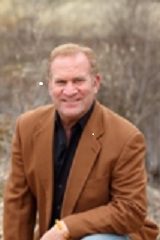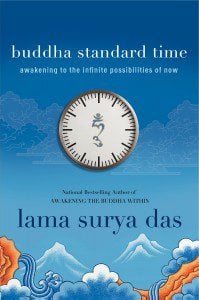This week we present an interview with Lama Surya Das (bio at bottom, though well known to most of you). For the interview I solicited questions from friends and colleagues and chose a few to present to Surya Das. My great thanks to Lama Surya Das for taking the time to answer these questions and to the wonderful Erica Taylor for helping to bring this together, as well as to my friends Nick M, Nick W, Katherin, Emily, Warren, and Margaret for the questions. The first three questions focus on personal life and practice, while the last three focus on Buddhism in America. So, let us begin:
1) How do I “look for” or see the Buddha in my daily life? I understand Buddhism doesn’t emphasize a guiding relationship with any god figure; however, I enjoy the positive feeling in “seeing god around.” Can I grow that in Buddhist practice?
Buddha said that all beings are endowed with the luminous tathagata-garbha, or innate Buddha nature. We experienced Vajrayana (diamond path) meditators practice seeing the Buddha-nature, the buddhaness, the clear light in everyone and everything. That is what I like to call The Diamond Rule. Then we can grow closer to “Buddha” every moment, wherever we are, like what theists like to call the constant companion; and Buddha continues to radiate through us, beyond separation or joining. This practice is like an invisible friend with benefits!
“Wherever I go, I meet mySelf,” said a great Zen master of old. In Tibetan Buddhism, we have prayerful devotional practices such as “Calling the Master from Afar” which help us invoke and invite, exhort and bring closer the object of our respect and devotion, mainly in order to realize our primordial inseparability with him/That and open a world of sacredness before our eyes and our feet as we tread that path of a new awakefulness.
2) What is the best way to explain sunyata to a person who is curious about Buddhism but who refuses to budge on the idea of an “independent soul”? Is accepting the doctrine of no-self truly a key element for Buddhist practitioners in the West?
Mindfulness is probably the blue jeans of Buddhism in the West, good for any and all occasions, much more useful and effective for most of us than mere faith or doctrines. Sunyata and anatta—emptiness, and no-separate-independent-self– are the hardest nuts to crack in Buddhist thought. To explain sunyata to the uninitiated and unreceptive seems unnecessary and possibly contraindicated. However, exploring together the universal facts of impermanence and so forth can help loosen some clinging and dogmatism regarding various notions and concepts, including the soul theory. Anyway, it’d take a better man than you or me to clearly distinguish between the doctrine of soul, on one hand, and that of the unchanging and immaculate, unborn and undying Buddha nature or Dharmakaya, on the other hand– though people do try to teach about and explain that.
Let me go further in making waves where there’s no wind: How different, really—to the layperson, at least– is the theistic creator-God doctrine, from Tibetan Buddhism’s talk about the primordial Buddha, the primordial protector, the all-doer Samantabhadra? When we meditate and practice loving kindness and self-inquiry, and compassion in action, our hardheadedness and hardheartedness softens and certain distinctions and attachments, doctrinal or otherwise, can become a lot less problematic.
3) What is the place of dark retreats within the Buddhist tradition? How should one deal with difficult experiences within retreat?
Dark retreats as I know them in Tibetan Buddhism are mainly for practicing the bardo (afterlife) meditation experiences, and involves training in it for days and weeks at a time so as to be better prepared for when the moment of transition occurs. The secret Dzogchen practice of Togal (“leap over”, or “being there”) is also practiced sometime over periods of time in complete darkness. Removing visual along with other outer sense stimuli can help enhance and illuminate the “inner senses” and increase ones capacity for and experience of certain visionary realities. These kind of intensive practices are somewhat advanced and thus best undertaken with skilled guidance, to allow us to better develop and integrate all the experiences which occur along the path of practice.
4) What is a challenge unique to American Buddhist culture, and how can we use the experience of that challenge to grow stronger in the dharma?
One could mention challenges we face such as speediness and impatience; the habit and expectation of instant gratification; the commodifcation, thinning out and over- simplification of almost everything, and other particularly American character traits. Technology too plays its part, but cannot be turned back.
However, let me speculate that the big one is the great American leveling of everything, conducive to the common denominator and a sort of mere mediocrity rather than the great Golden Mean. ‘Good enough’ can too easily become the near-enemy of true excellence. The de-hierarchization of most if not all things in our society—although still suffering from racism and other forms of class inequality and even warfare, gross and subtle—leads to a disregard and utter disrespect from natural hierarchies of purity and intention, learning, experience, wisdom– and now, even of facts, where post-modern relativism and big money combine to make it impossible for the average person to sort through and sort out the facts, to the point where there are none in play and the loudest voice triumphs. This ignores the ancient American dictum that “All people are created equal, some more equal than others.”
We are drying up soul-wise and dying for spiritual elders and enlightened leaders whom we can trust and rely on to help us through dark times. For example, who has the chops and moxie to help us bring back the ‘higher’ into Higher Education, a wholistic life-wisdom education and emotional intelligence? Who embodies and serves the positive changes and qualities we long to see in the world today?
If these wounds and challenges are to become gifts, we have to be candid and dig deeper into ourselves and together carve out a new way and a new future, that future which begins now.
5) What do you think of the recent revelations of inappropriate behaviour towards their students by Western-born (as opposed to Tibetan-born) Tibetan Buddhist teachers, specifically Ken McLeod and Michael Roach?
It’s too soon to say, since the facts are not yet complete in these two cases; but I did write something about the general issue for the Huffington Post in late June of this year, called “ Spiritual Responsibility and Cult Awareness-<http://www.
Whatever the relative merits (or demerits) of these particular cases are, or may turn out to be, or the local legalities, social mores, and commonly accepted norms; the complex and troubling problems arising through inappropriate behavior between teachers and students, priests and parishioners, the top dog and the underdog etc. is an old and pernicious one (sexual misconduct, exploitation, misuse of power, pedophilia, incest, rape etc.). This turns out to be more far-ranging and pervasive than originally thought, in most if not all of the religious and other power structure institutions today, and extending to sports coaches, therapy couches, medical offices, old age homes and hospitals, corporate settings and so forth, as the informed public has now been finding out. What we can do to help alleviate this affliction is our task at hand.
6) Recently, my friend Charles Prebish brought up your 10-fold plan for the American Buddhism of the future. In your 1997 “Awakening the Buddha Within” bestseller, you described the Ten Emerging Trends of American Buddhism: (1) Dharma without dogma; (2) a lay-oriented sangha; (3) a meditation-based and experiential sangha; (4) gender equality; (5) a nonsectarian tradition; (6) an essentialized and simplified tradition; (7) an egalitarian, democratic, and nonhierarchical tradition; (8) a psychologically astute and rational traditional; (9) an experimental, innovating, inquiry-based tradition; and (10) a socially informed and engaged tradition. Prebish endorsed most of this plan in his 1999 “Luminous Passage” book. How do you think this plan looks today? Are there any changes you’d make, given the last decade?
These ten trends seem even more prominent and developed than before. I suppose neuroscience has come on strong in the past fifteen years, as well as contemplative education and also Internet Dharma, but these are within the purview of the Ten Trends, especially numbers 8 and 9.
7) And lastly, perhaps the most relevant question for many of our daily lives in the next couple months: Who do you think will win the Super Bowl?
My team will definitely win!
About Lama Surya Das
Lama Surya Das is one of the foremost Western Buddhist meditation teachers and scholars. The Dalai Lama affectionately calls him “the American Lama”. He has spent nearly forty years studying Zen, Vipassana, Yoga, and Tibetan Buddhism with many of the great old masters of Asia, among them, some of the Dalai Lama’s own teachers. He is an authorized lama in the Tibetan Buddhist order, a leading spokesperson for Buddhism and contemporary spirituality, a translator, poet, meditation master, chant master, and spiritual activist. Lama Surya Das is the author of the international bestselling Awakening trilogy: Awakening the Buddha Within, Awakening to the Sacred and Awakening the Buddhist Heart, as well as the recently released Buddha Standard Time (HarperCollins), and nine other books. In 1991 he established the Dzogchen Centers and Dzogchen Retreats (www.dzogchen.org) and in 1993, with the Dalai Lama, he founded the Western Buddhist Teachers Network and regularly organizes its International Buddhist Teachers’ Conferences.
Lama Surya Das resides in Concord, Massachusetts.Today, Lama Surya Das teaches and lectures around the world, conducting dozens of meditation retreats and workshops each year. He is a regular contributor at Beliefnet.com, Tricycle magazine, and The Huffington Post. His blog, Ask The Lama, can be found at http://askthelama.com and his lecture and retreat schedule are listed at www.surya.org. He can also be followed on Facebook (Lama Surya Das) and Twitter (@LamaSuryaDas).













